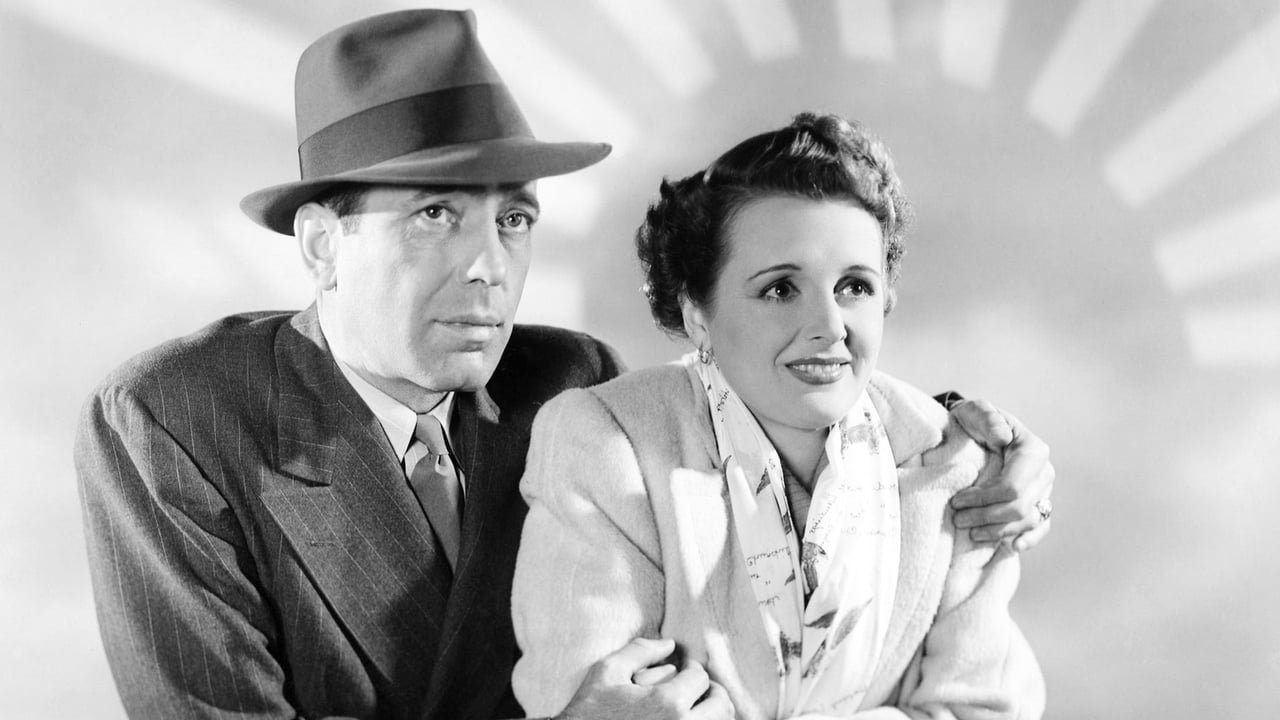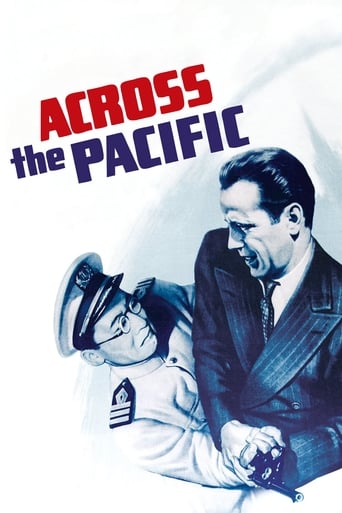Infamousta
brilliant actors, brilliant editing
Holstra
Boring, long, and too preachy.
Taha Avalos
The best films of this genre always show a path and provide a takeaway for being a better person.
Quiet Muffin
This movie tries so hard to be funny, yet it falls flat every time. Just another example of recycled ideas repackaged with women in an attempt to appeal to a certain audience.
jacobs-greenwood
Directed by John Huston, though finished by Vincent Sherman when Huston was called into war service, with a screenplay by Richard Macaulay that was based on a story by Robert Carson (or Garson, depending upon the source), this war adventure attempted to recapture the magic that director Huston shared with three of its leads in the previous year's The Maltese Falcon (1941).In this one, Humphrey Bogart plays Rick Leland (in his next film, he would play his most famous Rick; Blaine in Casablanca (1942)), Mary Astor plays Alberta Marlow, and Sydney Greenstreet plays Dr. Lorenz. All three are involved in an intrigue that couldn't have been more timely, a Japanese attempt to blow up the Panama Canal (the original story involved Pearl Harbor, hence the film's incongruent title, which actually was attacked during the production). It captures the style, if not the substance, of the earlier film.Artilleryman Leland is bucked out the service just before his country would be forced in World War II, a curious time to dishonorably discharged; John Hamilton plays the court-martial president. It's a ruse by the U.S. Military Intelligence intended to draw enemy spies to the ex-soldier, who may be able to provide information they need. Leland goes through the motions of attempting to enlist in the Canadian army before he boards a ship headed to the Orient where he hopes to serve China and Chiang Kai-shek against Japan. He meets, and is curiously attracted to Alberta, but their would-be romance has a rough start (she gets seasick; later, she gets sunburned). Leland also meets, and is befriended by, some other passengers: Dr. Lorenz and Joe Totsuiko (Sen Young). After sharing drinks and pretending to be both intoxicated and willing to part with certain strategic details for a price, Leland learns that Dr. Lorenz is a buyer of just this type of information; he's working for the Japanese.There's plenty of intrigue, and a lot of it's confusing (intentional or otherwise). Rick's not sure if Alberta has any connection to his dealings with Lorenz, or whether to trust her - at first she wants to help him, but later she disappears. Once the ship from New York reaches Panama, the plot thickens. Charles Halton plays A. V. Smith, Rick's go-between who gives the ex-soldier a schedule of air patrols to reel in Lorenz. Lee Tung Foo plays a friend of Rick's, a Panamanian hotel proprietor, that assists Rick. Plus, the usual suspects in these war pictures, Richard Loo and Keye Luke, also play roles (as does Philip Ahn, though uncredited). Smith is killed, Rick is knocked out, and eventually everything leads to a plantation where it is learned that Dan Morton (Monte Blue) is being held. Alberta is Morton's daughter, and both were being played by Lorenz. Naturally, Rick recovers, saves the day and the Panama Canal.
blanche-2
Films made around this time always have an interesting behind the scenes story, and "Across the Pacific" from 1942 is no different.Rick Leland (Humphrey Bogart) is court-marshaled and booted out of the service; he then heads for Canada and attempts to enlist, but the Canadians know who he is and say they can't use him.Leland then leaves on a Japanese ship for the Orient, making no bones about the fact that his talents are for sale! He meets an attractive woman, Alberta Marlow (Mary Astor) and one Dr. Lorenz (Sidney Greenstreet). Lorenz loves the Japanese and its people, and speaks the language very well.You'll probably guess most of this.This is a Maltese Falcon template, with the exception of the absence of Peter Lorre. John Huston directed, but when we entered the war, he left to do documentary films for the government. Vincent Sherman started the film at a difficult moment in the action, and he asked Huston how a particular situation would be resolved. Huston said, "That's your problem!" and left.Originally this film had to do with stopping an attack on Pearl Harbor, but we all know what happened there, so the plot was changed to the Panama Canal.I liked this film - there is a lot of light repartee between Bogart and Astor, which is fun and makes the film less intense than it might have been. They worked very well together. And you really can't beat Sidney Greenstreet when it comes to being slimy.The majority of the Japanese in the movie were actually Chinese since most of the Japanese were interred, a black mark not often discussed, which is odd.Some exciting action and solid work by all the cast.
utgard14
Good WW2 spy movie with the three leads and director from The Maltese Falcon. The plot is about Humphrey Bogart getting tangled up with baddie Sydney Greenstreet and love interest Mary Astor. Greenstreet's a Japanese sympathizer and is trying to recruit Bogie. Good luck with that, Gutman. Bogart is excellent playing a character he was totally at home playing: wisecracking tough guy ladies' man. Greenstreet is villainous as ever and perfect at it. Just as in Maltese Falcon, Mary Astor is playing a stunning beauty that makes heads turn. Just like in Maltese Falcon, she doesn't match the character description. Perhaps Huston had a bit of a crush. Otherwise I don't get her being cast in these types of parts at a time when the likes of Ingrid Bergman and Lana Turner were around. Still, despite that element of the casting being off, Astor does fine.This movie has an interesting backstory. It was originally to be about a Japanese attack on Pearl Harbor but when that actually happened in real life, they changed it to Panama. They never changed the title, though, despite the movie taking place nowhere near the Pacific. Then John Huston got called to serve before filming was complete so Vincent Sherman had to step in. Oddly, it seems Huston was the only one who knew how the movie was supposed to end so Sherman had to make up the final fifteen minutes or so of the movie!
SimonJack
Over the years, I've come to look for posted comments from a few specific people who are frequent film reviewers. They usually have some interesting information or data related to the film, the cast or the staff. And, their tastes and interests seem to follow mine closely. Without mentioning any names, I found a couple of those regulars who commented on "Across the Pacific," but with whom I differed a lot. I think many reviewers missed a great deal in this movie. For one thing, most seemed to focus on one or two cast members. Several said that Bogie's performance was just OK and not on a par with most of his best work. Many seemed to want to evaluate this film only or mostly on the basis of it being a propaganda piece. With that goes an apparent assumption that all propaganda is all bad – or that it could have no other value on which to be judged or enjoyed. Too bad for those narrow views. I found this film very entertaining, very interesting and considerably intriguing. Indeed, I think it may be one of the best films of the Hollywood golden age in the group of multi-faceted genres. And what a number of genres it is – mystery, espionage, comedy, romance, action, war, drama and adventure. Of course, starting off, the viewer isn't aware of these many facets of the film, unless one has read a review or comments. But they unfold very nicely in the movie. This film has a great blend of intrigue, witticism, romance and action. The script is excellent and the writing is crisp and clever. The several exchanges between Bogart and Astor are delightful and show the genius of the screenwriters. Here's a sample when Bogart is called to Astor's cabin to help cool off her sunburn (which he had warned her against twice). Before that, she had been freezing on deck in shorts trying to get a tan; and she had gotten seasick after eating desert when the 'boat' hit rough seas. Bogie – "You sure are a girl of many colors. First your legs get blue, then your face turns green, and now you're red all over." Astor – "I never knew what suffering was 'til I came on this 'pleasure' trip." Bogie – "Your trouble is ... you always have all the answers – 'til the results are posted."Sydney Greenstreet is a delight, as always. There are a number of scenes when he gives the stoic mini-monologues he is so identified with that paint him a man of culture, refinement and education. However cunning and clever he may be, aside. This has a fresh, crisp script for all involved. And, the propaganda aspects of the film are very neatly woven into the intrigue and romance. The film came out Sept. 5, 1942, and although the plot is fiction, we are all too aware of the time and circumstances. On the day the passengers arrive in Panama and Bogie visits a contact in a bank, the contact hands him a newspaper that has the all too-familiar headlines of peace prospects promised by the Japanese right up to the time of Pearl Harbor. The date on the paper is December 6, 1941. The new DVD in the Bogart film collection I bought also has some interesting extras. One is a color short, "Men of the Sky," about the Army Air Corps. It's a promo film and shows pilot training and a talk by Gen. Hap Arnold who commanded the Army Air Forces during WWII, and later commanded the U.S. Air Force. Another interesting short is "Hollywood helps the Cause." It tells about the role of film companies and movie stars during WWII.

